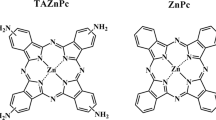Abstract
Objective
To investigate the effect of 5-aminolevulinic acid (ALA) mediated photodynamic therapy (PDT) on U251 human glioma cells in vitro.
Methods
U251 human glioma cells were routinely cultured and then treated with ALA, a type of photosensitizer, at various concentrations followed by light irradiation. The PDT-induced phototoxicity of the cells was determined by a MTT assay. In addition, cells were treated with ALA at a fixed concentration and subjected to various doses of light irradiation.
Results
With the same light dosage (25.0 J/cm2), the cell survival rates were 70.16%±5.02%, 50.19%±4.79%, 34.97%±5.34%, 27.04%±4.34%, and 24.26% ±2.76% at ALA concentrations of 0.25, 0.5, 1.0, 2.0, and 4.0 mM, respectively (F =279.88, P =0.0000). But the survival rates of the cells incubated with 2.0 mM ALA compared to those with 4.0 mM ALA (27.04%±4.34% vs 24.26%±2.76%) showed no significant difference (P=0.611 ). At a single ALA concentration, the cell survival rates were 83.48% ± 6.79%, 68.09%±6.02%, 33.75%± 6.70%, 23.34%± 5.08% and 15.14%± 3.60% for light doses of 6.25,12.5, 25.0,50.0, and 100 J/cm2, respectively (F=422.03, P=0.0000). Without exposure to light, however, the cell survival rates were 96.64% ±6.56%, 97.71% ±5.48%, 98.10% ±6.25%, 99.44% ±7.02%, and 95.86% ±7.80% for ALA concentrations at 0.25, 0.5, 1.0, 2.0, and 4.0 mM, respectively (F=0.68,P =0.6085). Without ALA in the medium, the cell survival rates were 98.74% ±6.20%, 96.49% ±7.13%, 97.60% ±5.94%, 95.70%±4.86%, 98.08%±6.26% for light doses of 6.25, 12.5, 25.0, 50.0, and 100 J/cm2, respectively (F=0.6400, P=0.6368).
Conclusion
The PDT damage to the U251 cells increased with ALA concentration within a relative lower range, but then plateaued at higher concentrations. PDT damage was proportional to the doses of irradiated light. Without ALA, the light alone caused no photodynamic damage and ALA itself was nontoxic. The ALA-induced PDT appears to be a promising therapy for glioma.
Similar content being viewed by others
References
Jiang F, Robin AM, Katakowski M, et al. Photodynamic therapy with photofrin in combination with Buthionine Sulfoximine (BSO) of human glioma in the nude rat. Lasers Med Sci. 2003; 3:128–133.
Wu SM, Ren QG, Zhou MO, et al. Protoporphyrin IX production and its photodynamic effects on glioma cells, neuroblastoma cells and normal cerebellar granule cells in vitro with 5-aminolevulinic acid and its hexylester. Cancer Lett. 2003; 2:123–131.
Madsen SJ, Sun CH, Tromberg BJ, et al.Repetitive 5-aminolevulinic acidmediated photodynamic therapy on human glioma spheroids. J Neurooncol. 2003; 3:243–250.
Jiang F, Chopp M, Katakowski M, et al.Photodynamic therapy with photofrin reduces invasiveness of malignant human glioma cells. Lasers Med Sci. 2002; 4:280–288.
Madsen SJ, Sun CH, Tromberg BJ, et al. Effects of combined photodynamic therapy and ionizing radiation on human glioma spheroids. Photochem Photobiol. 2002; 4:411–416.
Yang VX, Muller PJ, Herman P, et al. A multispectral fluorescence imaging system: design and initial clinical tests in intra-operative Photofrin-photodynamic therapy of brain tumors. Lasers Surg Med. 2003; 3:224–232.
Hirschberg H, Sun CH, Tromberg BJ, et al. ALA- and ALAestermediated photodynamic therapy of human glioma spheroids. J Neurooncol. 2002; 1:1–7.
Madsen SJ, Sun CH, Tromberg BJ, et al. Photodynamic therapy of human glioma spheroids using 5-aminolevulinic acid. Photochem Photobiol. 2000; 1:128–134.
Tsai JC, Hsiao YY, Teng LJ, et al. Comparative study on the ALA photodynamic effects of human glioma and meningioma cells. Lasers Surg Med. 1999; 4:296–305.
Krishnamurthy S, Powers SK, Witmer P, et al. Optimal light dose for interstitial photodynamic therapy in treatment for malignant brain tumors. Lasers Surg Med. 2000; 3:224–234.
Schreiber S, Gross S, Brandis A, et al. Local photodynamic therapy (PDT) of rat C6 glioma xenografts with Pd bacteriopheophorbide leads to decreased metastases and increase of animal cure compared with surgery. Int J Cancer. 2002; 2:279–285.
Author information
Authors and Affiliations
Additional information
This work was supported by the National Natural Science Foundation of China (No. 30170961).
About this article
Cite this article
Ding, L., Xu, R., Jiang, X. et al. 5-aminolevulinic acid - mediated photodynamic therapy of human glioma cells in vitro. Chin. J. Clin. Oncol. 1, 256–261 (2004). https://doi.org/10.1007/BF02739810
Received:
Accepted:
Issue Date:
DOI: https://doi.org/10.1007/BF02739810




